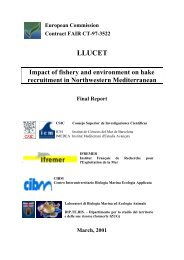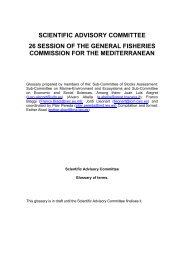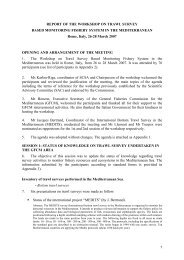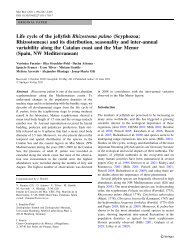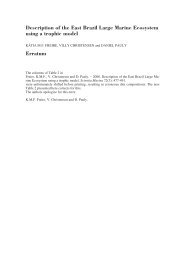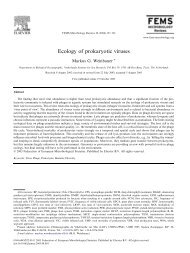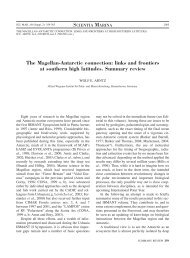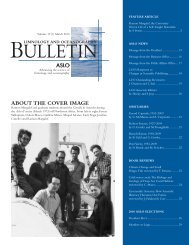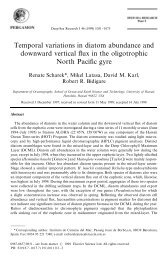Unveiling new microbial eukaryotes in the surface ocean
Unveiling new microbial eukaryotes in the surface ocean
Unveiling new microbial eukaryotes in the surface ocean
Create successful ePaper yourself
Turn your PDF publications into a flip-book with our unique Google optimized e-Paper software.
Available onl<strong>in</strong>e at www.sciencedirect.com<br />
<strong>Unveil<strong>in</strong>g</strong> <strong>new</strong> <strong>microbial</strong> <strong>eukaryotes</strong> <strong>in</strong> <strong>the</strong> <strong>surface</strong> <strong>ocean</strong><br />
Ramon Massana and Carlos Pedrós-Alió<br />
A decade after molecular techniques were used to discover<br />
novel bacteria and archaea <strong>in</strong> <strong>the</strong> <strong>ocean</strong>s, <strong>the</strong> same approach<br />
has revealed a wealth of <strong>new</strong> mar<strong>in</strong>e eukaryotic microbes. The<br />
approach has been particularly successful with <strong>the</strong> smallest<br />
<strong>eukaryotes</strong>, where morphological and culture approaches<br />
frequently fail. Analysis of samples from <strong>the</strong> <strong>surface</strong> <strong>ocean</strong>, <strong>the</strong><br />
most accessible and supposedly well-known <strong>ocean</strong>ic region,<br />
reveals novel eukaryotic diversity at all different levels: from <strong>the</strong><br />
highest taxonomic rank to <strong>the</strong> lowest microdiverse clusters.<br />
Moreover, mar<strong>in</strong>e eukaryotic assemblages show a large<br />
diversity with members belong<strong>in</strong>g to many different l<strong>in</strong>eages.<br />
The implication of this large and novel eukaryotic diversity for<br />
biodiversity surveys and ecosystem function<strong>in</strong>g opens <strong>new</strong><br />
avenues for future research.<br />
Address<br />
Department of Mar<strong>in</strong>e Biology and Oceanography, Institut de Ciències<br />
del Mar, CSIC, Passeig Marítim de la Barceloneta 37-49, 08003<br />
Barcelona, Catalonia, Spa<strong>in</strong><br />
Correspond<strong>in</strong>g author: Massana, Ramon (ramonm@icm.csic.es)<br />
Current Op<strong>in</strong>ion <strong>in</strong> Microbiology 2008, 11:213–218<br />
This review comes from a <strong>the</strong>med issue on<br />
Ecology and <strong>in</strong>dustrial microbiology<br />
Edited by Juan Ramos and Mart<strong>in</strong> Keller<br />
Available onl<strong>in</strong>e 13th June 2008<br />
1369-5274/$ – see front matter<br />
# 2008 Elsevier Ltd. All rights reserved.<br />
DOI 10.1016/j.mib.2008.04.004<br />
Introduction<br />
Microorganisms are known to play essential roles <strong>in</strong><br />
natural systems. In <strong>the</strong> <strong>surface</strong> <strong>ocean</strong>s <strong>the</strong>y are present<br />
<strong>in</strong> large abundances, account for a significant share of<br />
planktonic biomass, and are central <strong>in</strong> biogeochemical<br />
cycles. Yet, <strong>the</strong>y are a heterogeneous collection of organisms<br />
with a substantial diversity of form, size, life style,<br />
and phylogenetic affiliation, and <strong>the</strong>y are pooled toge<strong>the</strong>r<br />
only because of <strong>the</strong>ir <strong>in</strong>visibility to <strong>the</strong> naked eye [1 ].<br />
Many microorganisms, especially <strong>the</strong> smallest ones, cannot<br />
be identified under <strong>the</strong> microscope, because <strong>the</strong>y lack<br />
conspicuous morphological features. This is well known<br />
<strong>in</strong> prokaryotes, which have only a handful of possible<br />
morphologies. Only after molecular surveys retriev<strong>in</strong>g<br />
SSU rDNA sequences directly from <strong>the</strong> environment<br />
were carried out, <strong>the</strong> phylogenetic affiliation of mar<strong>in</strong>e<br />
prokaryotes was known. The first studies on <strong>the</strong> molecular<br />
diversity of mar<strong>in</strong>e bacteria [2] and archaea [3]<br />
unveiled a substantial amount of <strong>new</strong> diversity and<br />
revealed that most microorganisms available <strong>in</strong> pure<br />
culture were not dom<strong>in</strong>ant <strong>in</strong> <strong>the</strong> mar<strong>in</strong>e plankton.<br />
Microbial <strong>eukaryotes</strong>, <strong>in</strong> turn, were not considered <strong>in</strong><br />
<strong>the</strong>se early approaches, despite <strong>the</strong> fact that <strong>the</strong> smaller<br />
<strong>eukaryotes</strong> were also difficult to be identified morphologically.<br />
In most conventional studies of mar<strong>in</strong>e plankton,<br />
<strong>the</strong>se organisms were usually lumped <strong>in</strong> a black box<br />
labeled ‘small flagellates’. The grow<strong>in</strong>g recognition of <strong>the</strong><br />
importance of <strong>the</strong>se m<strong>in</strong>ute <strong>eukaryotes</strong> as primary producers,<br />
bacterial grazers, and parasites paralleled <strong>the</strong> <strong>in</strong>terest<br />
of identify<strong>in</strong>g <strong>the</strong> species of <strong>the</strong>se probably very<br />
diverse assemblages. The first molecular surveys of mar<strong>in</strong>e<br />
<strong>eukaryotes</strong> confirmed <strong>the</strong> existence of significant<br />
novel diversity with<strong>in</strong> <strong>the</strong> protistan world [4 ,5 ,6 ].<br />
This approach has benefited from recent efforts to build a<br />
robust framework of eukaryotic evolution with<strong>in</strong> which<br />
environmental sequences can be placed. Virtually all<br />
eukaryotic organisms can be grouped <strong>in</strong>to a few supergroups.<br />
Each one is composed by dist<strong>in</strong>ct l<strong>in</strong>eages (most<br />
are protists) that are held toge<strong>the</strong>r by phylogenetic signatures<br />
and some ultrastructural characters [7,8 ,9]. For<br />
<strong>in</strong>stance, <strong>the</strong> supergroup opisthokonta <strong>in</strong>cludes metazoans,<br />
fungi, and choanoflagellates. Here we analyze and<br />
summarize <strong>the</strong> novel diversity of mar<strong>in</strong>e <strong>microbial</strong> <strong>eukaryotes</strong><br />
as revealed by molecular studies <strong>in</strong> <strong>the</strong> <strong>surface</strong> of<br />
<strong>the</strong> <strong>ocean</strong>s.<br />
A <strong>new</strong> w<strong>in</strong>dow <strong>in</strong>to protistan diversity <strong>in</strong> <strong>the</strong><br />
sea<br />
Introduction of molecular tools <strong>in</strong> <strong>microbial</strong> ecology has<br />
become <strong>the</strong> key to access <strong>the</strong> phylogenetic and functional<br />
diversity of mar<strong>in</strong>e microbes [10]. The basis is to extract<br />
total DNA from a community, to amplify a marker gene<br />
(18S rDNA <strong>in</strong> <strong>eukaryotes</strong>) by PCR, and to clone and<br />
sequence <strong>the</strong> PCR products for phylogenetic identification.<br />
The first molecular surveys of mar<strong>in</strong>e <strong>eukaryotes</strong><br />
targeted <strong>the</strong> smallest cells (pico<strong>eukaryotes</strong>, 3 mm <strong>in</strong><br />
size) from <strong>surface</strong> [4 ,6 ] and deep [5 ] <strong>ocean</strong>ic<br />
samples. Extreme environments, such as anoxic water<br />
column and sediments [11,12] and hydro<strong>the</strong>rmal vents<br />
[13] were <strong>in</strong>spected soon after, <strong>in</strong> <strong>the</strong> search for <strong>the</strong> limits<br />
of eukaryotic life and <strong>the</strong> most divergent and ancient<br />
l<strong>in</strong>eages. After <strong>the</strong> sequenc<strong>in</strong>g effort, specific oligonucleotide<br />
probes could be designed and applied through<br />
fluorescent <strong>in</strong> situ hybridization (FISH) to visualize <strong>the</strong><br />
target cells <strong>in</strong> natural samples and to determ<strong>in</strong>e <strong>the</strong>ir<br />
distribution and abundance. This has been done for<br />
groups hav<strong>in</strong>g both cultured [14] and uncultured<br />
[15,16 ,17] representatives. It is <strong>in</strong> <strong>the</strong> latter case where<br />
FISH exploits its full potential, allow<strong>in</strong>g to put a face (cell<br />
size, rough shape, chlorophyll presence) to novel l<strong>in</strong>eages<br />
www.sciencedirect.com Current Op<strong>in</strong>ion <strong>in</strong> Microbiology 2008, 11:213–218
214 Ecology and <strong>in</strong>dustrial microbiology<br />
Table 1<br />
Affiliation of 18S rDNA sequences from <strong>surface</strong> picoplankton <strong>in</strong> <strong>the</strong> coast (23 libraries and 1349 clones) and open sea (12 libraries and 826<br />
clones) from studies that reported <strong>the</strong> clonal distribution among phylogenetic groups<br />
Supergroup First rank Second rank n % clones Habitat Novelty a<br />
Archaeplastida Chloroplastida Pras<strong>in</strong>ophytae 261 15.0 Coast Low<br />
Chlorophyta 2 0.1 –<br />
Chromalveolata Alveolates Ciliophora 137 4.9 Coast Medium<br />
D<strong>in</strong>ozoa 173 5.3 Low*<br />
MA-I 363 14.6 High<br />
MA-II 417 17.6 Coast High<br />
Stramenopiles Bicosoecida 20 0.4 Low<br />
Bolidophyceae 21 0.4 Low<br />
Chrysophyceae 65 2.7 Medium<br />
Diatoms 27 2.5 Low*<br />
Dictyochophyceae 25 1.1 Low<br />
Eustigmatales 2 0.4 –<br />
Labyr<strong>in</strong>thulids 14 0.5 Medium<br />
MASTs 237 13.4 Offshore High<br />
Oomycetes 8 0.2 –<br />
Pelagophyceae 12 1.0 Offshore Low<br />
Pirsonia 3 0.1 –<br />
Basal groups Cryptophyceae 64 2.4 Coast Low*<br />
Haptophyta 53 4.5 Offshore Low*<br />
Katablepharis 6 0.2 –<br />
Telonema 14 0.4 Medium<br />
Excavata Euglenozoa K<strong>in</strong>etoplastea 1 0.0 –<br />
Opisthokonta Choanoflagellates 16 1.0 Medium<br />
Fungi 16 0.8 High<br />
Rhizaria Cercozoa 53 2.6 Coast Medium<br />
Chlorarachniophyte-like 11 0.3 High<br />
Radiolaria 90 5.6 Offshore High<br />
Not assigned Apusomonads 11 0.2 Low<br />
Picobiliphyta 24 0.9 High<br />
Inserta sedis 29 0.7 High<br />
Data derive from Pacific, Atlantic, Indian, and Sou<strong>the</strong>rn Oceans, and <strong>the</strong> Mediterranean and North Seas [4 ,6 ,22–27]. The number of clones, <strong>the</strong><br />
average contribution of each group (normalized by <strong>the</strong> number of clones <strong>in</strong> each system), <strong>the</strong> coast-offshore trend, and a rough <strong>in</strong>dication of <strong>the</strong> level<br />
of novel diversity detected with<strong>in</strong> <strong>the</strong> group are shown.<br />
a Low: most clones are 98% similar to cultured relatives (* <strong>in</strong>dicates a significant presence of more divergent clones); medium: most clones are 92–<br />
98% similar to cultured relatives; high: most clones are
<strong>Unveil<strong>in</strong>g</strong> <strong>new</strong> <strong>microbial</strong> <strong>eukaryotes</strong> <strong>in</strong> <strong>the</strong> <strong>surface</strong> <strong>ocean</strong> Massana and Pedrós-Alió 215<br />
High-rank novel diversity: more than <strong>the</strong> six<br />
supergroups?<br />
The first molecular surveys of mar<strong>in</strong>e protists claimed <strong>the</strong><br />
discovery of novel groups that deserved <strong>the</strong> highest<br />
taxonomic rank, which could not be placed with<strong>in</strong> any<br />
of <strong>the</strong> eukaryotic supergroups [5 ,11,12]. Many of <strong>the</strong>se<br />
sequences derived from anoxic systems. However, it was<br />
soon shown that some of <strong>the</strong>se highly divergent<br />
groups were unsupported because of <strong>the</strong> presence of<br />
undetected chimeras, misplacement of fast evolv<strong>in</strong>g<br />
l<strong>in</strong>eages, and <strong>in</strong>complete representation of cultured<br />
stra<strong>in</strong>s [31 ,32,33]. However, several sequences still form<br />
robust and deep clades and thus rema<strong>in</strong> as candidates for<br />
novel high-rank taxonomic groups. They are found at low<br />
clonal abundance so, probably, <strong>the</strong>y are not very important<br />
ecologically. Instead, <strong>the</strong>ir <strong>in</strong>terest is that <strong>the</strong>y might<br />
represent different pathways <strong>in</strong> eukaryotic evolution.<br />
Perhaps <strong>the</strong> best example is <strong>the</strong> picobiliphytes, a novel<br />
phytoplanktonic class that is not close to any supergroup<br />
[17]. Picobiliphyte cells are 3–4 mm <strong>in</strong> size, putatively<br />
conta<strong>in</strong> a plastid with phycobil<strong>in</strong> pigments, and can be<br />
locally abundant [15]. O<strong>the</strong>r high-rank groups await careful<br />
scrut<strong>in</strong>y, because each library often yields a few<br />
sequences impossible to be classified to a given supergroup.<br />
Twenty-n<strong>in</strong>e clones of <strong>the</strong> overview presented<br />
here could not be assigned to a given supergroup<br />
(Table 1). The similarity of <strong>the</strong>se sequences is often<br />
below 75% to any o<strong>the</strong>r known 18S rDNA. Some of <strong>the</strong>m<br />
appear <strong>in</strong> more than one system, thus exclud<strong>in</strong>g <strong>the</strong><br />
possibility of be<strong>in</strong>g chimeras. Exhaustive phylogenetic<br />
reconstructions, renovated cultur<strong>in</strong>g efforts, and<br />
additional sequences from s<strong>in</strong>gle cells are needed to<br />
understand <strong>the</strong> biological nature of <strong>the</strong>se putative<br />
high-rank l<strong>in</strong>eages.<br />
Intermediate-rank novel diversity: novel<br />
eukaryotic l<strong>in</strong>eages<br />
A large number of sequences form clades that affiliate to a<br />
given eukaryotic supergroup but without a clear affiliation<br />
to any def<strong>in</strong>ed group. Among <strong>the</strong>se, <strong>the</strong> mar<strong>in</strong>e alveolates<br />
(MAs) and mar<strong>in</strong>e stramenopiles (MASTs) are particularly<br />
<strong>in</strong>terest<strong>in</strong>g because <strong>the</strong>y appear <strong>in</strong> virtually all<br />
mar<strong>in</strong>e surveys. MAs are divided <strong>in</strong>to two ma<strong>in</strong> groups,<br />
MA-I and MA-II, which form robust l<strong>in</strong>eages equivalent<br />
to <strong>the</strong> o<strong>the</strong>r alveolate groups. Their placement is still<br />
unresolved, because SSU analysis places <strong>the</strong>m closer to<br />
d<strong>in</strong>oflagellates [34], whereas a recent LSU tree places<br />
<strong>the</strong>m closer to perk<strong>in</strong>sids [21]. The sequence diversity<br />
conta<strong>in</strong>ed <strong>in</strong> <strong>the</strong> two groups is huge, with at least 5 clades<br />
with<strong>in</strong> MA-I and up to 16 clades with<strong>in</strong> MA-II [35 ].<br />
Besides <strong>the</strong>ir genetic diversity, <strong>the</strong>se groups appear at a<br />
very high clonal abundance, 14.6% for MA-I and 17.6%<br />
for MA-II. Soon after <strong>the</strong> description of MAs, Amoebophrya<br />
(a d<strong>in</strong>oflagellate parasite) was sequenced and<br />
affiliated to MA-II [36]. Additional sequences of parasites<br />
have been later published with<strong>in</strong> both MA-I and MA-II<br />
[34,37,38]. Therefore, it has been proposed that <strong>the</strong> whole<br />
assemblage is composed of parasites of mar<strong>in</strong>e organisms.<br />
Perhaps, <strong>the</strong> specific <strong>in</strong>teraction with different hosts<br />
could expla<strong>in</strong> <strong>the</strong>ir large genetic diversity. Their considerable<br />
clonal abundance and diversity suggests an<br />
important role for parasitism as a trophic relationship <strong>in</strong><br />
<strong>the</strong> open sea.<br />
MASTs form more than 10 clades at <strong>the</strong> basal part of <strong>the</strong><br />
stramenopiles [39 ], where all protists are heterotrophic,<br />
<strong>in</strong>clud<strong>in</strong>g free-liv<strong>in</strong>g phagotrophic flagellates (bicosoecids),<br />
parasites (Blastocystis), or osmotrophs (oomycetes<br />
and labyr<strong>in</strong>thulids). MASTs are ra<strong>the</strong>r abundant (13.4%<br />
of clones), and a few clades (MAST-1, MAST-3, MAST-<br />
4, and MAST-7) account for most sequences (<strong>the</strong> o<strong>the</strong>r<br />
clades have lower clonal abundances or are specific of<br />
anoxic systems). The heterotrophic nature of MASTs,<br />
first suspected by <strong>the</strong>ir phylogenetic placement, was<br />
confirmed by FISH for clade-1, clade-2, and clade-4<br />
[16 ]. These are small protists (2–8 mm <strong>in</strong> size), able<br />
to grow <strong>in</strong> <strong>the</strong> dark and to <strong>in</strong>gest bacteria. These MAST<br />
cells are widely distributed and account for a significant<br />
fraction of heterotrophic flagellates globally. One group <strong>in</strong><br />
particular, MAST-4, is found <strong>in</strong> all samples (except <strong>the</strong><br />
polar ones) as a very small protist (2–3 mm <strong>in</strong> size), its<br />
abundance averages 130 cells ml<br />
1 , and accounts for 9%<br />
of heterotrophic flagellates. Overall, <strong>the</strong>se results reveal<br />
that still-uncultured groups can be dom<strong>in</strong>ant <strong>in</strong> <strong>the</strong><br />
<strong>ocean</strong>s and highlight <strong>the</strong> ecological relevance of <strong>the</strong> novel<br />
diversity detected by <strong>the</strong> molecular approach.<br />
Low-rank novel diversity: known l<strong>in</strong>eages are<br />
more diverse than thought<br />
This is represented by sequences that clearly affiliate to a<br />
given l<strong>in</strong>eage but are not identical to any characterized<br />
protist. Low-rank novel diversity is extensive, because<br />
environmental sequences are identical to cultured stra<strong>in</strong>s<br />
only <strong>in</strong> a few cases. For <strong>in</strong>stance, only 11 out of 510 partial<br />
sequences retrieved from <strong>the</strong> Indian Ocean [24] were<br />
identical (over 800–900 bp) to cultured stra<strong>in</strong>s: Caecitellus<br />
parvulus, Micromonas pusilla, and Ostreococcus RCC 143.<br />
This list would <strong>in</strong>clude Bathycoccus pras<strong>in</strong>os, Amastigomonas<br />
debruynei, Gymnod<strong>in</strong>ium sp., and Pelagomonas calceolata<br />
if 1–2 mismatches were accepted (ano<strong>the</strong>r 21 clones). So,<br />
between 94 and 98% of <strong>the</strong> sequences retrieved from this<br />
mar<strong>in</strong>e system represent <strong>new</strong> diversity not expla<strong>in</strong>ed by<br />
cultured protists.<br />
Obviously, <strong>the</strong>re are degrees of novelty at this lower<br />
phylogenetic level. Thus, pras<strong>in</strong>ophytes show <strong>the</strong> best<br />
correspondence between molecular and cultur<strong>in</strong>g<br />
approaches, and <strong>the</strong> 18S rDNA sequences from <strong>the</strong> field<br />
and cultures are identical or very close [40]. O<strong>the</strong>r important<br />
groups often represented by environmental<br />
sequences closely related to cultured stra<strong>in</strong>s are <strong>the</strong><br />
bicosoecids, bolidophytes, d<strong>in</strong>oflagellates, and pelagophytes.<br />
These closely related sequences most probably<br />
www.sciencedirect.com Current Op<strong>in</strong>ion <strong>in</strong> Microbiology 2008, 11:213–218
216 Ecology and <strong>in</strong>dustrial microbiology<br />
identify <strong>the</strong> same cultured stra<strong>in</strong> <strong>in</strong> <strong>the</strong> environment,<br />
closely related species, or ecotypes of <strong>the</strong> same species.<br />
O<strong>the</strong>r groups conta<strong>in</strong> a much larger level of diversity. So,<br />
important mar<strong>in</strong>e groups such as <strong>the</strong> ciliates, choanoflagellates,<br />
chrysophytes, cryptophytes, diatoms, and haptophytes<br />
are represented by environmental sequences<br />
that can range from 94 to 100% sequence similarlity to<br />
cultured relatives. This implies that some novel clades<br />
exist with<strong>in</strong> all <strong>the</strong>se groups, <strong>in</strong>creas<strong>in</strong>g substantially <strong>the</strong><br />
diversity <strong>the</strong>y conta<strong>in</strong>. For <strong>in</strong>stance, up to three novel<br />
clades have been identified with<strong>in</strong> <strong>the</strong> choanoflagellates,<br />
and three novel clades with<strong>in</strong> chrysophytes after analyz<strong>in</strong>g<br />
mar<strong>in</strong>e sequences (del Campo, Massana, unpublished).<br />
A substantial fraction of clones from <strong>the</strong> open sea affiliate<br />
with <strong>the</strong> radiolarians (10% on average). This is surpris<strong>in</strong>g,<br />
because <strong>the</strong> radiolarian species known so far are ra<strong>the</strong>r<br />
large (typically around 100 mm) and most possess m<strong>in</strong>eralized<br />
skeletons. Mar<strong>in</strong>e radiolarian sequences are<br />
diverse, generally highly distant to sequenced protists,<br />
and form at least five clades, two related to acanthareans,<br />
one to polycyst<strong>in</strong>ea, and two to taxopodida [23]. Whereas<br />
it is known that many described radiolarian species have<br />
not been sequenced, given <strong>the</strong> difficulty of <strong>the</strong>ir isolation,<br />
it is not clear if <strong>the</strong>se would expla<strong>in</strong> <strong>the</strong> sequences found<br />
<strong>in</strong> environmental surveys. The existence of <strong>the</strong>se diverse<br />
radiolarian sequences from <strong>the</strong> picoplankton rema<strong>in</strong>s as<br />
an <strong>in</strong>trigu<strong>in</strong>g enigma.<br />
Microdiversity of natural assemblages<br />
Prokaryotic diversity is normally structured <strong>in</strong> clades<br />
conta<strong>in</strong><strong>in</strong>g highly related but seldom identical sequences<br />
[41,42]. The evolutionary and ecological mean<strong>in</strong>g of this<br />
microdiversity is not well understood, though it has been<br />
proposed that it is a consequence of <strong>the</strong> asexual mode of<br />
prokaryotic reproduction toge<strong>the</strong>r with ecological factors<br />
[43]. Microdiverse clusters would exist because of neutral<br />
mutations (also <strong>in</strong> <strong>the</strong> 18S rDNA) dur<strong>in</strong>g asexual divisions,<br />
so that all <strong>the</strong> members would occupy <strong>the</strong> same<br />
ecological niche. When one of <strong>the</strong>se members acquires a<br />
selective advantage, periodic selective sweeps would<br />
purge all variability with<strong>in</strong> <strong>the</strong> cluster. Thus, current<br />
microdiverse clusters would exist due to <strong>the</strong> accumulation<br />
of neutral mutations s<strong>in</strong>ce <strong>the</strong> last selective sweep [44]. It<br />
is not clear whe<strong>the</strong>r this scenario also holds for <strong>microbial</strong><br />
<strong>eukaryotes</strong>. First, it has to be demonstrated that <strong>microbial</strong><br />
<strong>eukaryotes</strong> show microdiversity <strong>in</strong> nature. Some data<br />
suggest that this may be <strong>the</strong> case, at least for some groups<br />
such as MASTs [39 ] and MAs [35 ]. Second, even though<br />
cell division <strong>in</strong> <strong>microbial</strong> <strong>eukaryotes</strong> is mostly asexual, it is<br />
known (at least for some groups) that sexual events also<br />
occur, and <strong>the</strong>se would certa<strong>in</strong>ly impact <strong>the</strong> genetic<br />
structure of populations by mak<strong>in</strong>g populations more<br />
homogeneous. It is improbable that sexually compatible<br />
organisms show any variation with<strong>in</strong> <strong>the</strong> 18S rDNA.<br />
Current Op<strong>in</strong>ion <strong>in</strong> Microbiology 2008, 11:213–218<br />
Mat<strong>in</strong>g experiments with related diatom stra<strong>in</strong>s show<strong>in</strong>g<br />
some genetic structure reveal that only those with an<br />
identical 18S rDNA are sexually compatible [45 ]. If this<br />
applies to o<strong>the</strong>r mar<strong>in</strong>e populations, <strong>the</strong>n each different<br />
18S rDNA sequence, even with a s<strong>in</strong>gle base pair difference,<br />
would mean an <strong>in</strong>dependent and evolutionarily<br />
isolated l<strong>in</strong>eage, <strong>in</strong>creas<strong>in</strong>g protist diversity enormously.<br />
Thus, <strong>the</strong> actual microdiversity structure with<strong>in</strong> particular<br />
protistan l<strong>in</strong>eages deserves a better study, toge<strong>the</strong>r<br />
with studies to unravel <strong>the</strong> sexual nature of mar<strong>in</strong>e<br />
protists.<br />
Conclusions<br />
The analysis of <strong>the</strong> 18S rDNA sequences retrieved from<br />
<strong>the</strong> sea reveals that mar<strong>in</strong>e protists are very diverse,<br />
<strong>in</strong>creas<strong>in</strong>g substantially <strong>the</strong> known amount of diversity<br />
with<strong>in</strong> <strong>the</strong> eukaryotic tree of life. Current parametric and<br />
nonparametric estimates of protistan richness [46]<br />
<strong>in</strong>dicate that hundreds to thousands of dist<strong>in</strong>ct protistan<br />
taxa can coexist <strong>in</strong> a s<strong>in</strong>gle mar<strong>in</strong>e sample [25,28,29].<br />
Most probably, microorganisms do not deviate from <strong>the</strong><br />
trend of <strong>in</strong>creas<strong>in</strong>g number of species with decreas<strong>in</strong>g<br />
<strong>in</strong>dividual size [47,48]. As shown here, <strong>the</strong> relatively low<br />
number of <strong>microbial</strong> species actually described is largely<br />
because of <strong>the</strong> under-representation of <strong>microbial</strong> diversity<br />
<strong>in</strong> culture collections. The availability of powerful<br />
and relatively cheap sequenc<strong>in</strong>g techniques will be essential<br />
to determ<strong>in</strong>e <strong>the</strong> dimensions of such diversity.<br />
Ano<strong>the</strong>r <strong>in</strong>terest<strong>in</strong>g po<strong>in</strong>t is that <strong>the</strong> <strong>in</strong>crease <strong>in</strong> mar<strong>in</strong>e<br />
eukaryotic diversity occurs at almost all possible phylogenetic<br />
scales. Thus, putative high-rank groups occur,<br />
novel clades with<strong>in</strong> supergroups have been identified,<br />
and novel diversity is detected with<strong>in</strong> all known l<strong>in</strong>eages,<br />
from closely <strong>new</strong> species, genera, families, or orders. The<br />
challenge is to retrieve <strong>in</strong> culture <strong>the</strong> organisms responsible<br />
for such sequences and to determ<strong>in</strong>e <strong>the</strong>ir trophic<br />
role and ecological function.<br />
References and recommended read<strong>in</strong>g<br />
Papers of particular <strong>in</strong>terest, published with<strong>in</strong> <strong>the</strong> period of review,<br />
have been highlighted as:<br />
1.<br />
<br />
of special <strong>in</strong>terest<br />
of outstand<strong>in</strong>g <strong>in</strong>terest<br />
Sherr EB, Sherr BF: Mar<strong>in</strong>e microbes. An overview.In Microbial<br />
Ecology of <strong>the</strong> Oceans. Edited by Kirchman DL. New York: Wiley-<br />
Liss; 2000:13-46.<br />
This book chapter is a good <strong>in</strong>troduction to <strong>the</strong> ma<strong>in</strong> groups of mar<strong>in</strong>e<br />
microorganisms, organized by sizes, classes, general taxonomic assemblages,<br />
and functional groups.<br />
2. Giovannoni SJ, Britschgi TB, Moyer CL, Field KG: Genetic<br />
diversity <strong>in</strong> Sargasso Sea bacterioplankton. Nature 1990,<br />
345:60-63.<br />
3. DeLong EF: Archaea <strong>in</strong> coastal mar<strong>in</strong>e environments. Proc Natl<br />
Acad Sci U S A 1992, 89:5685-5689.<br />
4.<br />
<br />
Díez B, Pedrós-Alió C, Massana R: Study of genetic diversity of<br />
eukaryotic picoplankton <strong>in</strong> different <strong>ocean</strong>ic regions by smallsubunit<br />
rRNA gene clon<strong>in</strong>g and sequenc<strong>in</strong>g. Appl Environ<br />
Microbiol 2001, 67:2932-2941.<br />
www.sciencedirect.com
<strong>Unveil<strong>in</strong>g</strong> <strong>new</strong> <strong>microbial</strong> <strong>eukaryotes</strong> <strong>in</strong> <strong>the</strong> <strong>surface</strong> <strong>ocean</strong> Massana and Pedrós-Alió 217<br />
This is one of <strong>the</strong> first studies that report mar<strong>in</strong>e picoeukaryotic diversity<br />
by analyz<strong>in</strong>g 18S rDNA genes directly retrieved from <strong>the</strong> environment. It<br />
compares data from distant <strong>surface</strong> waters and derives <strong>the</strong> general<br />
patterns of protistan diversity: high diversity and novel groups.<br />
5.<br />
<br />
López-García P, Rodríguez-Valera F, Pedrós-Alió C, Moreira D:<br />
Unexpected diversity of small <strong>eukaryotes</strong> <strong>in</strong> deep-sea<br />
Antarctic plankton. Nature 2001, 409:603-607.<br />
This is one of <strong>the</strong> first studies that report mar<strong>in</strong>e picoeukaryotic diversity by<br />
sequenc<strong>in</strong>g environmental 18S rDNA genes, with special focus on deep<br />
<strong>ocean</strong>ic samples as examples of extreme and undersampled systems.<br />
6.<br />
<br />
Moon-van der Staay SY, De Wachter R, Vaulot D: Oceanic 18S<br />
rDNA sequences from picoplankton reveal unsuspected<br />
eukaryotic diversity. Nature 2001, 409:607-610.<br />
This is one of <strong>the</strong> first studies that report mar<strong>in</strong>e picoeukaryotic diversity<br />
by sequenc<strong>in</strong>g environmental 18S rDNA genes from a very oligotrophic<br />
<strong>ocean</strong>ic sample.<br />
7. Adl SM, Simpson AGB, Farmer MA, Andersen RA, Anderson OR,<br />
Barta JR, Bowser SS, Brugerolle G, Fensome RA, Fredericq S<br />
et al.: The <strong>new</strong> higher level classification of <strong>eukaryotes</strong> with<br />
emphasis on <strong>the</strong> taxonomy of protists. J Eukaryot Microbiol<br />
2005, 52:399-451.<br />
8. Baldauf SL: The deep roots of <strong>eukaryotes</strong>. Science 2003,<br />
300:1703-1706.<br />
This article is one of <strong>the</strong> first efforts to summarize all eukaryotic diversity<br />
<strong>in</strong>to a few supergroups (eight <strong>in</strong> this study) us<strong>in</strong>g <strong>the</strong> <strong>in</strong>formation ga<strong>the</strong>red<br />
<strong>in</strong> multigene phylogenetic trees.<br />
9. Simpson AGB, Roger AJ: The real ‘‘k<strong>in</strong>gdoms’’ of <strong>eukaryotes</strong>.<br />
Curr Biol 2004, 14:R693-R696.<br />
10. Pace NR: A molecular view of <strong>microbial</strong> diversity and <strong>the</strong><br />
biosphere. Science 1997, 276:734-740.<br />
11. Dawson SC, Pace NR: Novel k<strong>in</strong>gdom-level eukaryotic diversity<br />
<strong>in</strong> anoxic environments. Proc Natl Acad Sci U S A 2002, 99:8324-<br />
8329.<br />
12. Stoeck T, Epste<strong>in</strong> S: Novel eukaryotic l<strong>in</strong>eages <strong>in</strong>ferred from<br />
small-subunit rRNA analyses of oxygen-depleted mar<strong>in</strong>e<br />
environments. Appl Environ Microbiol 2003, 69:2657-2663.<br />
13. Edgcomb VP, Kysela DT, Teske A, de Vera Gomez A, Sog<strong>in</strong> ML:<br />
Benthic eukaryotic diversity <strong>in</strong> <strong>the</strong> Guaymas Bas<strong>in</strong><br />
hydro<strong>the</strong>rmal vent environment. Proc Natl Acad Sci U S A 2002,<br />
99:7658-7662.<br />
14. Not F, Latasa M, Marie D, Cariou T, Vaulot D, Simon N: A s<strong>in</strong>gle<br />
species, Micromonas pusilla (Pras<strong>in</strong>ophyceae), dom<strong>in</strong>ates <strong>the</strong><br />
eukaryotic picoplankton <strong>in</strong> <strong>the</strong> Western English Channel. Appl<br />
Environ Microbiol 2004, 70:4064-4072.<br />
15. Cuvelier M, Ortiz A, Kim E, Moehlig H, Richardson DE,<br />
Heidelberg JF, Archibald JM, Worden AZ: Widespread<br />
distribution of a unique mar<strong>in</strong>e protistan l<strong>in</strong>eage. Environ<br />
Microbiol 2008, 10:1621-1634.<br />
16.<br />
<br />
Massana R, Terrado R, Forn I, Lovejoy C, Pedrós-Alió C:<br />
Distribution and abundance of uncultured heterotrophic<br />
flagellates <strong>in</strong> <strong>the</strong> world <strong>ocean</strong>s. Environ Microbiol 2006, 8:1515-<br />
1522.<br />
This article applies FISH to visualize uncultured protists and report <strong>the</strong>ir<br />
cell size and abundance. These are globally distributed heterotrophic<br />
flagellates with a significant abundance.<br />
17. Not F, Valent<strong>in</strong> K, Romari K, Lovejoy C, Massana R, Töbe K,<br />
Vaulot D, Medl<strong>in</strong> L: Picobiliphytes: a mar<strong>in</strong>e picoplanktonic<br />
algal group with unknown aff<strong>in</strong>ities to o<strong>the</strong>r <strong>eukaryotes</strong>.<br />
Science 2007, 315:252-254.<br />
18. Venter JC, Rem<strong>in</strong>gton K, Heidelberg JF, Halpern AL, Rusch D,<br />
Eisen JA, Wu D, Paulsen I, Nelson KE, Nelson W et al.:<br />
Environmental genome shotgun sequenc<strong>in</strong>g of <strong>the</strong> Sargasso<br />
Sea. Science 2004, 304:66-74.<br />
19. DeLong EF, Preston CM, M<strong>in</strong>cer T, Rich V, Hallam SJ, Frigaard N-U,<br />
Mart<strong>in</strong>ez A, Sullivan MB, Edwards R, Rodriguez Brito B et al.:<br />
Community genomics among stratified <strong>microbial</strong> assemblages<br />
<strong>in</strong> <strong>the</strong> <strong>ocean</strong>’s <strong>in</strong>terior. Science 2006, 311:496-503.<br />
20.<br />
<br />
Rusch DB, Halpern AL, Sutton G, Heidelberg KB, Williamson S,<br />
Yooseph S, Wu D, Eisen JA, Hoffman JM, Rem<strong>in</strong>gton K et al.: The<br />
Sorcerer II global <strong>ocean</strong> sampl<strong>in</strong>g expedition: northwest<br />
Atlantic through eastern tropical Pacific. PLoS Biol 2007, 5:398-<br />
431.<br />
This article presents a paramount amount of genetic <strong>in</strong>formation from<br />
<strong>surface</strong> mar<strong>in</strong>e microorganisms by do<strong>in</strong>g a systematic metagenomic<br />
survey across a wide <strong>ocean</strong>ographic transect.<br />
21. Massana R, Karniol B, Pommier T, Bodaker I, Béjà O:<br />
Metagenomic retrieval of a ribosomal DNA repeat array from<br />
an uncultured mar<strong>in</strong>e alveolate. Environ Microbiol 2008,<br />
10:1335-1343.<br />
22. Worden AZ: Picoeukaryote diversity <strong>in</strong> coastal waters of <strong>the</strong><br />
Pacific Ocean. Aquat Microb Ecol 2006, 43:165-175.<br />
23. Not F, Gausl<strong>in</strong>g R, Azam F, Heidelberg JF, Worden AZ: Vertical<br />
distribution of picoeukaryotic diversity <strong>in</strong> <strong>the</strong> Sargasso Sea.<br />
Environ Microbiol 2007, 9:1233-1252.<br />
24. Not F, Latasa M, Scharek R, Viprey M, Karlesk<strong>in</strong>d P, Balagué V,<br />
Ontoria I, Cum<strong>in</strong>o A, Goetze E, Vaulot D et al. Protistan<br />
assemblages across <strong>the</strong> Indian Ocean, with a specific<br />
emphasis on <strong>the</strong> pico<strong>eukaryotes</strong>. Deep Sea Res, <strong>in</strong> press.<br />
25. Massana R, Balagué V, Guillou L, Pedrós-Alió C: Picoeukaryotic<br />
diversity <strong>in</strong> an oligotrophic coastal site studied by molecular<br />
and cultur<strong>in</strong>g approaches. FEMS Microbiol Ecol 2004, 50:231-<br />
243.<br />
26. Medl<strong>in</strong> LK, Metfies K, Mehl H, Wiltshire K, Valent<strong>in</strong> K:<br />
Picoeukaryotic plankton diversity at <strong>the</strong> Helgoland time series<br />
site as assessed by three molecular methods. Microb Ecol<br />
2006, 52:53-71.<br />
27. Romari K, Vaulot D: Composition and temporal variability of<br />
picoeukaryote communities at a coastal site of <strong>the</strong> English<br />
Channel from 18S rDNA sequences. Limnol Oceanogr 2004,<br />
49:784-798.<br />
28. Countway PD, Gast RJ, Savai P, Caron DA: Protistan diversity<br />
estimates based on 18S rDNA from seawater <strong>in</strong>cubations <strong>in</strong> <strong>the</strong><br />
western North Atlantic. J Eukaryot Microbiol 2005, 52:95-106.<br />
29. Countway PD, Gast RJ, Dennet MR, Savai P, Rose JM, Caron DA:<br />
Dist<strong>in</strong>ct protistan assemblages characterize <strong>the</strong> euphotic<br />
zone and deep sea (2500 m) of <strong>the</strong> western North Atlantic<br />
(Sargasso Sea and Gulf Stream). Environ Microbiol 2007,<br />
9:1219-1232.<br />
30. Lovejoy C, Massana R, Pedrós-Alió C: Diversity and distribution<br />
of mar<strong>in</strong>e <strong>microbial</strong> <strong>eukaryotes</strong> <strong>in</strong> <strong>the</strong> Arctic Ocean and<br />
adjacent seas. Appl Environ Microbiol 2006, 72:3085-3095.<br />
31.<br />
<br />
Berney C, Fahrni J, Pawlowski J: How many novel eukaryotic<br />
‘‘k<strong>in</strong>gdoms’’? Pitfalls and limitations of environmental DNA<br />
surveys. BMC Biol 2004, 2:1-13.<br />
This article performs a rigorous check on <strong>the</strong> claims of novel high-rank<br />
diversity <strong>in</strong> <strong>the</strong> <strong>in</strong>itial molecular surveys. Some sequences were shown to<br />
be artifacts, but candidates for high-rank diversity still rema<strong>in</strong>.<br />
32. Cavalier-Smith T: Only six k<strong>in</strong>gdoms of life. Proc R Soc Lond B<br />
2004, 271:1251-1262.<br />
33. Epste<strong>in</strong> S, López-García P:‘‘Miss<strong>in</strong>g’’ protists: a molecular<br />
prospective. Biodivers Conserv 2008, 17:261-276.<br />
34. Skovgaard A, Massana R, Balagué V, Saiz E: Phylogenetic<br />
position of <strong>the</strong> copepod-<strong>in</strong>fest<strong>in</strong>g parasite Synd<strong>in</strong>ium turbo<br />
(D<strong>in</strong>oflagellata, Synd<strong>in</strong>ea). Protist 2005, 156:413-423.<br />
35.<br />
<br />
Groisillier A, Massana R, Valent<strong>in</strong> K, Vaulot D, Guillou L: Genetic<br />
diversity and habitats of two enigmatic mar<strong>in</strong>e alveolate<br />
l<strong>in</strong>eages. Aquat Microb Ecol 2006, 42:277-291.<br />
This article summarizes and labels <strong>the</strong> genetic diversity with<strong>in</strong> uncultured<br />
mar<strong>in</strong>e alveolates (MAs) retrieved from mar<strong>in</strong>e pico<strong>eukaryotes</strong>.<br />
36. Gunderson JH, John SA, Boman WC II, Coats DW: Multiple<br />
stra<strong>in</strong>s of <strong>the</strong> parasitic d<strong>in</strong>oflagellate Amoebophrya exist <strong>in</strong><br />
Chesapeake Bay. J Eukaryot Microbiol 2002, 49:469-474.<br />
37. Dolven JK, L<strong>in</strong>dqvist C, Albert VA, Bjørklund KR, Yuasa T,<br />
Takahashi O, Mayama S: Molecular diversity of alveolates<br />
associated with neritic North Atlantic radiolarians. Protist<br />
2007, 158:65-76.<br />
38. Harada A, Ohtsuka S, Horiguchi T: Species of <strong>the</strong> parasitic<br />
genus Duboscquella are members of <strong>the</strong> enigmatic mar<strong>in</strong>e<br />
alveolate group I. Protist 2007, 158:337-347.<br />
www.sciencedirect.com Current Op<strong>in</strong>ion <strong>in</strong> Microbiology 2008, 11:213–218
218 Ecology and <strong>in</strong>dustrial microbiology<br />
39.<br />
<br />
Massana R, Castresana J, Balagué V, Guillou L, Romari K,<br />
Groisillier A, Valent<strong>in</strong> K, Pedrós-Alió C: Phylogenetic and<br />
ecological analysis of novel mar<strong>in</strong>e stramenopiles. Appl<br />
Environ Microbiol 2004, 70:3528-3534.<br />
This article summarizes and labels <strong>the</strong> genetic diversity with<strong>in</strong> uncultured<br />
mar<strong>in</strong>e stramenopiles (MASTs) retrieved from mar<strong>in</strong>e pico<strong>eukaryotes</strong>.<br />
40. Guillou L, Eikrem W, Chrétiennot-D<strong>in</strong>et M-J, Le Gall F, Massana R,<br />
Romari K, Pedrós-Alió C, Vaulot D: Diversity of picoplanktonic<br />
Pras<strong>in</strong>ophyceae assessed by direct SSU rDNA sequenc<strong>in</strong>g of<br />
environmental samples and novel isolates retrieved from<br />
<strong>ocean</strong>ic and coastal mar<strong>in</strong>e ecosystems. Protist 2004, 155:193-<br />
214.<br />
41. Ac<strong>in</strong>as SG, Klepac-Ceraj V, Hunt DE, Phar<strong>in</strong>o C, Ceraj I, Distel DL,<br />
Polz MF: F<strong>in</strong>e-scale phylogenetic architecture of a complex<br />
bacterial community. Nature 2004, 430:551-554.<br />
42. Fuhrman JA, Campbell L: Microbial microdiversity. Nature 1998,<br />
393:410-411.<br />
43. Cohan FM: Towards a conceptual and operational union of<br />
bacterial systematics, ecology, and evolution. Philos Trans R<br />
Soc B 2006, 361:1985-1996.<br />
44. Giovannoni SJ: Oceans of bacteria. Nature 2004, 430:515-516.<br />
45.<br />
<br />
Amato A, Kooistra WHCF, Ghiron JHL, Mann DG, Pröschold T,<br />
Montresor M: Reproductive isolation among sympatric<br />
cryptic species <strong>in</strong> mar<strong>in</strong>e diatoms. Protist 2007, 158:<br />
193-207.<br />
This article compares <strong>the</strong> genetic distance, ultrastructure, and mat<strong>in</strong>g<br />
capacity of several diatom stra<strong>in</strong>s from <strong>the</strong> same species, show<strong>in</strong>g a<br />
remarkable consistency among <strong>the</strong> three identify<strong>in</strong>g properties.<br />
46. Jeon S-O, Bunge J, Stoeck T, Barger KJ-A, Hong S-H, Epste<strong>in</strong> SS:<br />
Syn<strong>the</strong>tic statistical approach reveals a high degree of<br />
richness of <strong>microbial</strong> <strong>eukaryotes</strong> <strong>in</strong> an anoxic water column.<br />
Appl Environ Microbiol 2006, 72:6578-6583.<br />
47. Hughes Mart<strong>in</strong>y JB, Bohannan BJM, Brown JH, Colwell RK,<br />
Fuhrman JA, Green JL, Horner-Dev<strong>in</strong>e MC, Kane M, Krum<strong>in</strong>s JA,<br />
Kuske CR et al.: Microbial biogeography: putt<strong>in</strong>g<br />
microorganisms on <strong>the</strong> map. Nat Rev 2006, 4:<br />
102-112.<br />
48. May RM: How many species are <strong>the</strong>re on Earth? Science 1988,<br />
241:1441-1449.<br />
Current Op<strong>in</strong>ion <strong>in</strong> Microbiology 2008, 11:213–218<br />
www.sciencedirect.com




